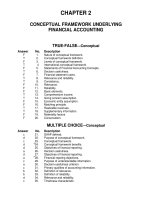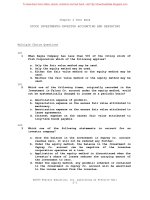business english 2e by mary chapter 02
Bạn đang xem bản rút gọn của tài liệu. Xem và tải ngay bản đầy đủ của tài liệu tại đây (774.92 KB, 47 trang )
2
Sentences
MARY ELLEN GUFFEY AND CAROLYN M. SEEFER
BUSINESS
ENGLISH
12e
© 2017 Cengage Learning®. May not be scanned, copied or duplicated, or posted to a publicly accessible website, in whole or in part, except for use as
permitted in a license distributed with a certain product or service or otherwise on a password-protected website or school-approved learning management
system for classroom use.
© Larysa Ray/Shutterstock. © Valeri Potapova/Shutterstock.
L E A R N I N G
O U T C O M E S
▶.
Recognize basic sentence elements including subjects and predicates.
▶.
Differentiate among phrases, dependent clauses, and independent
clauses.
▶.
Understand how to use simple, compound, complex, and compoundcomplex sentences.
▶.
Identify four basic sentence patterns.
▶.
Punctuate statements, questions, commands, and exclamations.
▶.
Use techniques to avoid three basic sentence faults: fragments,
comma splices, and run-on sentences.
© 2017 Cengage Learning®. May not be scanned, copied or duplicated, or posted to a publicly accessible website, in whole or in part, except for use as permitted in a license distributed with a certain product or service or otherwise on a password-protected website or school-approved learning management system for classroom use.
© Larysa Ray/Shutterstock
2
Sentence Elements
© 2017 Cengage Learning®. May not be scanned, copied or duplicated, or posted to a publicly accessible website, in whole or in part, except for use as permitted in a license distributed with a certain product or service or otherwise on a password-protected website or school-approved learning
© 2017 Cengage Learning®. May not be scanned, copied or duplicated, or posted to a publicly accessible website, in whole or in part, except for use as permitted in a license distributed with a certain product or service or otherwise on a password-protected website or school-approved learning management system for classroom use.
management system for classroom use. © Larysa Ray/Shutterstock
© Larysa Ray/Shutterstock
3
Sentence
Sentence: A group of words that:
Contains a subject
Includes a predicate
Expresses a complete thought
Sentence
Subject
Elements
Predicate
Completeness
© 2017 Cengage Learning®. May not be scanned, copied or duplicated, or posted to a publicly accessible website, in whole or in part, except for use as permitted in a license distributed with a certain product or service or otherwise on a password-protected website or school-approved learning
© 2017 Cengage Learning®. May not be scanned, copied or duplicated, or posted to a publicly accessible website, in whole or in part, except for use as permitted in a license distributed with a certain product or service or otherwise on a password-protected website or school-approved learning management system for classroom use.
management system for classroom use. © Larysa Ray/Shutterstock
© Larysa Ray/Shutterstock
4
Sentence
Elements
Subject
Simple subject: a noun or a pronoun that tells who or what the
sentence is about
Complete subject: includes all modifiers
© 2017 Cengage Learning®. May not be scanned, copied or duplicated, or posted to a publicly accessible website, in whole or in part, except for use as permitted in a license distributed with a certain product or service or otherwise on a password-protected website or school-approved learning
© 2017 Cengage Learning®. May not be scanned, copied or duplicated, or posted to a publicly accessible website, in whole or in part, except for use as permitted in a license distributed with a certain product or service or otherwise on a password-protected website or school-approved learning management system for classroom use.
management system for classroom use. © Larysa Ray/Shutterstock
© Larysa Ray/Shutterstock
5
Four Tips for Locating Subjects
To locate a sentence subject, ask Who or what is being discussed?
The manager hires all new employees.
Who is being discussed?
Training programs educate new employees.
What is being discussed?
© 2017 Cengage Learning®. May not be scanned, copied or duplicated, or posted to a publicly accessible website, in whole or in part, except for use as permitted in a license distributed with a certain product or service or otherwise on a password-protected website or school-approved learning
© 2017 Cengage Learning®. May not be scanned, copied or duplicated, or posted to a publicly accessible website, in whole or in part, except for use as permitted in a license distributed with a certain product or service or otherwise on a password-protected website or school-approved learning management system for classroom use.
management system for classroom use. © Larysa Ray/Shutterstock
© Larysa Ray/Shutterstock
6
Four Tips for Locating Subjects
Ignore prepositional phrases.
The manager of the program for all new
hires in our division
called a meeting.
Who is being discussed?
Where are the prepositional
phrases?
Sentences may have multiple subjects.
The president, controller, and
supervisor gave their approval.
Who is being discussed?
© 2017 Cengage Learning®. May not be scanned, copied or duplicated, or posted to a publicly accessible website, in whole or in part, except for use as permitted in a license distributed with a certain product or service or otherwise on a password-protected website or school-approved learning
© 2017 Cengage Learning®. May not be scanned, copied or duplicated, or posted to a publicly accessible website, in whole or in part, except for use as permitted in a license distributed with a certain product or service or otherwise on a password-protected website or school-approved learning management system for classroom use.
management system for classroom use. © Larysa Ray/Shutterstock
© Larysa Ray/Shutterstock
7
Four Tips for Locating Subjects
Reword inverted sentences to locate the subject.
Sitting in the front row is Rachel.
Who is being discussed?
Reword: Rachel is sitting in the
front row.
Did any other candidates qualify?
Who is being discussed?
Reword: Other candidates did
qualify?
© 2017 Cengage Learning®. May not be scanned, copied or duplicated, or posted to a publicly accessible website, in whole or in part, except for use as permitted in a license distributed with a certain product or service or otherwise on a password-protected website or school-approved learning
© 2017 Cengage Learning®. May not be scanned, copied or duplicated, or posted to a publicly accessible website, in whole or in part, except for use as permitted in a license distributed with a certain product or service or otherwise on a password-protected website or school-approved learning management system for classroom use.
management system for classroom use. © Larysa Ray/Shutterstock
© Larysa Ray/Shutterstock
8
Sentence
Elements
Predicate
Simple predicate: a verb or verb phrase that tells or asks what
the subject is doing or what is being done to the subject
Complete predicate: includes modifiers, objects, and
complements
© 2017 Cengage Learning®. May not be scanned, copied or duplicated, or posted to a publicly accessible website, in whole or in part, except for use as permitted in a license distributed with a certain product or service or otherwise on a password-protected website or school-approved learning
© 2017 Cengage Learning®. May not be scanned, copied or duplicated, or posted to a publicly accessible website, in whole or in part, except for use as permitted in a license distributed with a certain product or service or otherwise on a password-protected website or school-approved learning management system for classroom use.
management system for classroom use. © Larysa Ray/Shutterstock
© Larysa Ray/Shutterstock
9
TRY
TRY YOUR
YOUR SKILL
SKILL
In this sentence what is the
1. Simple subject?
2. Complete subject?
3. Simple predicate?
4. Complete predicate?
manager (simple subject)
A manager from ComStar (complete
subject)
has been calling (simple predicate)
has been calling you (complete
predicate)
A manager from ComStar has been calling
you.
© 2017 Cengage Learning®. May not be scanned, copied or duplicated, or posted to a publicly accessible website, in whole or in part, except for use as permitted in a license distributed with a certain product or service or otherwise on a password-protected website or school-approved learning
© 2017 Cengage Learning®. May not be scanned, copied or duplicated, or posted to a publicly accessible website, in whole or in part, except for use as permitted in a license distributed with a certain product or service or otherwise on a password-protected website or school-approved learning management system for classroom use.
management system for classroom use. © Larysa Ray/Shutterstock
© Larysa Ray/Shutterstock
10
Sentence
Elements
Completeness
In addition to having subjects and predicates, sentences must be complete.
Examples:
Two technology companies merged. (This sentence has a subject and a
predicate and is complete.)
Which explains the jump in stock price. (This fragment, broken off from
another sentence, is incomplete and doesn’t make sense.)
© 2017 Cengage Learning®. May not be scanned, copied or duplicated, or posted to a publicly accessible website, in whole or in part, except for use as permitted in a license distributed with a certain product or service or otherwise on a password-protected website or school-approved learning
© 2017 Cengage Learning®. May not be scanned, copied or duplicated, or posted to a publicly accessible website, in whole or in part, except for use as permitted in a license distributed with a certain product or service or otherwise on a password-protected website or school-approved learning management system for classroom use.
management system for classroom use. © Larysa Ray/Shutterstock
© Larysa Ray/Shutterstock
11
Recognizing Phrases and Clauses
Complete
Sentences
Phrases
Clauses
Phrase: a group of related words WITHOUT a subject and a verb
Kim came to the interview in the morning. She had been told to
arrive at 10 a.m. (These sentences have five different phrases. Can
you find them?)
© 2017 Cengage Learning®. May not be scanned, copied or duplicated, or posted to a publicly accessible website, in whole or in part, except for use as permitted in a license distributed with a certain product or service or otherwise on a password-protected website or school-approved learning
© 2017 Cengage Learning®. May not be scanned, copied or duplicated, or posted to a publicly accessible website, in whole or in part, except for use as permitted in a license distributed with a certain product or service or otherwise on a password-protected website or school-approved learning management system for classroom use.
management system for classroom use. © Larysa Ray/Shutterstock
© Larysa Ray/Shutterstock
12
Recognizing Phrases and Clauses
Complete
Sentences
Phrases
Clauses
Clause: a group of related words WITH a
subject and a verb
Independent clauses can stand alone.
Dependent clauses rely on independent
clauses for their meaning. Cannot stand alone.
When she arrived, she introduced herself. If she was afraid,
she didn’t show it. (Which clauses are independent?
Dependent?)
© 2017 Cengage Learning®. May not be scanned, copied or duplicated, or posted to a publicly accessible website, in whole or in part, except for use as permitted in a license distributed with a certain product or service or otherwise on a password-protected website or school-approved learning
© 2017 Cengage Learning®. May not be scanned, copied or duplicated, or posted to a publicly accessible website, in whole or in part, except for use as permitted in a license distributed with a certain product or service or otherwise on a password-protected website or school-approved learning management system for classroom use.
management system for classroom use. © Larysa Ray/Shutterstock
© Larysa Ray/Shutterstock
13
Sentence Varieties
© 2017 Cengage Learning®. May not be scanned, copied or duplicated, or posted to a publicly accessible website, in whole or in part, except for use as permitted in a license distributed with a certain product or service or otherwise on a password-protected website or school-approved learning
© 2017 Cengage Learning®. May not be scanned, copied or duplicated, or posted to a publicly accessible website, in whole or in part, except for use as permitted in a license distributed with a certain product or service or otherwise on a password-protected website or school-approved learning management system for classroom use.
management system for classroom use. © Larysa Ray/Shutterstock
© Larysa Ray/Shutterstock
14
Four Sentence Varieties
Simple sentence: has one independent clause―that is, one
clause that can stand alone
Each interviewee sent a résumé.
Compound sentence: has two or more independent clauses.
Kim spent many hours preparing her résumé, and she
practiced her answers to typical interview questions.
© 2017 Cengage Learning®. May not be scanned, copied or duplicated, or posted to a publicly accessible website, in whole or in part, except for use as permitted in a license distributed with a certain product or service or otherwise on a password-protected website or school-approved learning
© 2017 Cengage Learning®. May not be scanned, copied or duplicated, or posted to a publicly accessible website, in whole or in part, except for use as permitted in a license distributed with a certain product or service or otherwise on a password-protected website or school-approved learning management system for classroom use.
management system for classroom use. © Larysa Ray/Shutterstock
© Larysa Ray/Shutterstock
15
Four Sentence Varieties
Complex sentence: has one independent clause and one
dependent clause
When Kim arrived for the interview, she introduced herself to
the receptionist.
Compound-complex sentence: has two or more
independent clauses and one dependent clause
Because she had prepared well, Kim felt confident; she
answered all questions fully and enthusiastically.
© 2017 Cengage Learning®. May not be scanned, copied or duplicated, or posted to a publicly accessible website, in whole or in part, except for use as permitted in a license distributed with a certain product or service or otherwise on a password-protected website or school-approved learning
© 2017 Cengage Learning®. May not be scanned, copied or duplicated, or posted to a publicly accessible website, in whole or in part, except for use as permitted in a license distributed with a certain product or service or otherwise on a password-protected website or school-approved learning management system for classroom use.
management system for classroom use. © Larysa Ray/Shutterstock
© Larysa Ray/Shutterstock
16
Sentence Patterns
© 2017 Cengage Learning®. May not be scanned, copied or duplicated, or posted to a publicly accessible website, in whole or in part, except for use as permitted in a license distributed with a certain product or service or otherwise on a password-protected website or school-approved learning
© 2017 Cengage Learning®. May not be scanned, copied or duplicated, or posted to a publicly accessible website, in whole or in part, except for use as permitted in a license distributed with a certain product or service or otherwise on a password-protected website or school-approved learning management system for classroom use.
management system for classroom use. © Larysa Ray/Shutterstock
© Larysa Ray/Shutterstock
17
Pattern No. 1:
This is the most basic sentence
pattern
Subject-Verb
The subject is followed by its
verb.
EXAMPLES
Charlie called.
She is working.
All employees work.
© 2017 Cengage Learning®. May not be scanned, copied or duplicated, or posted to a publicly accessible website, in whole or in part, except for use as permitted in a license distributed with a certain product or service or otherwise on a password-protected website or school-approved learning
© 2017 Cengage Learning®. May not be scanned, copied or duplicated, or posted to a publicly accessible website, in whole or in part, except for use as permitted in a license distributed with a certain product or service or otherwise on a password-protected website or school-approved learning management system for classroom use.
management system for classroom use. © Larysa Ray/Shutterstock
© Larysa Ray/Shutterstock
18
Pattern No. 2:
Subject-Action Verb-Object
The subject is followed by an action verb and
its direct object.
The object usually answers the questions
What? and Whom?
EXAMPLES
ComStar created an Instagram account.
A law office hired her.
© 2017 Cengage Learning®. May not be scanned, copied or duplicated, or posted to a publicly accessible website, in whole or in part, except for use as permitted in a license distributed with a certain product or service or otherwise on a password-protected website or school-approved learning
© 2017 Cengage Learning®. May not be scanned, copied or duplicated, or posted to a publicly accessible website, in whole or in part, except for use as permitted in a license distributed with a certain product or service or otherwise on a password-protected website or school-approved learning management system for classroom use.
management system for classroom use. © Larysa Ray/Shutterstock
© Larysa Ray/Shutterstock
19
Pattern No. 3:
Subject-Linking Verb-
The subject is followed by a linking verb
and its complement.
Complement
Complement
Noun, pronoun, or adjective that renames
or describes the subject
Completes the meaning of the subject
© 2017 Cengage Learning®. May not be scanned, copied or duplicated, or posted to a publicly accessible website, in whole or in part, except for use as permitted in a license distributed with a certain product or service or otherwise on a password-protected website or school-approved learning
© 2017 Cengage Learning®. May not be scanned, copied or duplicated, or posted to a publicly accessible website, in whole or in part, except for use as permitted in a license distributed with a certain product or service or otherwise on a password-protected website or school-approved learning management system for classroom use.
management system for classroom use. © Larysa Ray/Shutterstock
© Larysa Ray/Shutterstock
20
Complement Examples
Pattern No. 3:
Subject-Linking Verb-Complement
Our receptionist is Patricia. (Noun complement)
The winner of the award is he. (Pronoun complement)
Their website is attractive. (Adjective complement)
© 2017 Cengage Learning®. May not be scanned, copied or duplicated, or posted to a publicly accessible website, in whole or in part, except for use as permitted in a license distributed with a certain product or service or otherwise on a password-protected website or school-approved learning
© 2017 Cengage Learning®. May not be scanned, copied or duplicated, or posted to a publicly accessible website, in whole or in part, except for use as permitted in a license distributed with a certain product or service or otherwise on a password-protected website or school-approved learning management system for classroom use.
management system for classroom use. © Larysa Ray/Shutterstock
© Larysa Ray/Shutterstock
21
Pattern No. 4:
Verbs may occasionally precede subjects.
Inverted Order
EXAMPLES
Chairing the committee is Renee Cornell.
There are three items we should discuss.
Here is my business card.
© 2017 Cengage Learning®. May not be scanned, copied or duplicated, or posted to a publicly accessible website, in whole or in part, except for use as permitted in a license distributed with a certain product or service or otherwise on a password-protected website or school-approved learning
© 2017 Cengage Learning®. May not be scanned, copied or duplicated, or posted to a publicly accessible website, in whole or in part, except for use as permitted in a license distributed with a certain product or service or otherwise on a password-protected website or school-approved learning management system for classroom use.
management system for classroom use. © Larysa Ray/Shutterstock
© Larysa Ray/Shutterstock
22
TRY
TRY YOUR
YOUR SKILL
SKILL
Rearrange these inverted sentences to
place them in normal subject-verb order.
1. Serving on the task force is Cathy Formusa. 1.
2. There are two candidates we are considering
for the position.
2.
Cathy Formusa is serving on the task
force.
We are considering two candidates for
the position.
3. Here is your authorization form.
3.
Your authorization form is here.
© 2017 Cengage Learning®. May not be scanned, copied or duplicated, or posted to a publicly accessible website, in whole or in part, except for use as permitted in a license distributed with a certain product or service or otherwise on a password-protected website or school-approved learning
© 2017 Cengage Learning®. May not be scanned, copied or duplicated, or posted to a publicly accessible website, in whole or in part, except for use as permitted in a license distributed with a certain product or service or otherwise on a password-protected website or school-approved learning management system for classroom use.
management system for classroom use. © Larysa Ray/Shutterstock
© Larysa Ray/Shutterstock
23
Sentence
Punctuation
© 2017 Cengage Learning®. May not be scanned, copied or duplicated, or posted to a publicly accessible website, in whole or in part, except for use as permitted in a license distributed with a certain product or service or otherwise on a password-protected website or school-approved learning
© 2017 Cengage Learning®. May not be scanned, copied or duplicated, or posted to a publicly accessible website, in whole or in part, except for use as permitted in a license distributed with a certain product or service or otherwise on a password-protected website or school-approved learning management system for classroom use.
management system for classroom use. © Larysa Ray/Shutterstock
© Larysa Ray/Shutterstock
24
Statements
Punctuating Four
Exclamations
Sentence
Questions
Types
Commands
© 2017 Cengage Learning®. May not be scanned, copied or duplicated, or posted to a publicly accessible website, in whole or in part, except for use as permitted in a license distributed with a certain product or service or otherwise on a password-protected website or school-approved learning
© 2017 Cengage Learning®. May not be scanned, copied or duplicated, or posted to a publicly accessible website, in whole or in part, except for use as permitted in a license distributed with a certain product or service or otherwise on a password-protected website or school-approved learning management system for classroom use.
management system for classroom use. © Larysa Ray/Shutterstock
© Larysa Ray/Shutterstock
25









